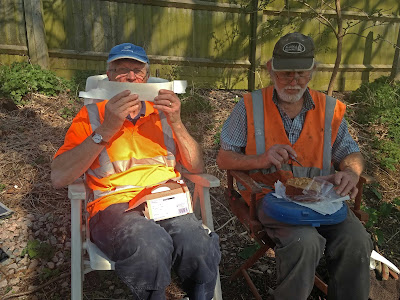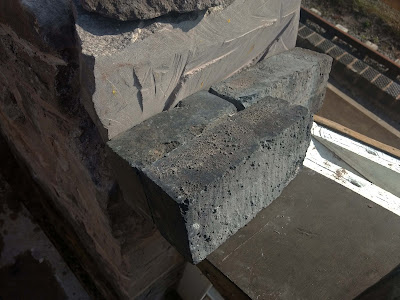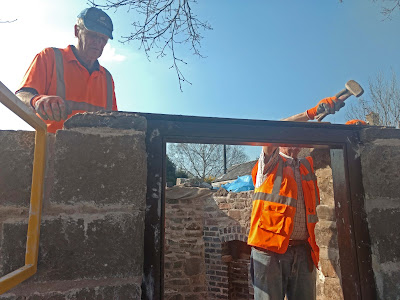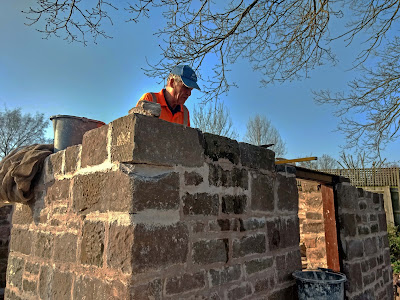Saturday with the gang.
A sunny day, good company, tea and doughnuts - just remembered why the PWay gang is so nice to work with. Why not come and join us? We are always open for new recruits.
On Saturday we had the job of correcting a kink in the line leading up to the Parlour Road at Toddington. The kink appeared after the crossover was renewed. The new crossover is standard; the old one was a bitsa and the Parlour Road was laid to accommodate that. Now there's a bit of a kink where the two meet.
We were a bit dejected when we turned up on site, and saw what had to be done. The side of the track was all buried in concrete. True, a cut had been made all the way along, but it was just 3 inches deep, and the ends of the sleepers would still be buried. We brought Kangos and had a little exploratory rattle at the concrete - it proved to be reinforced in two layers.
Ouch!
Saturday was a running day of course, so we had the spectacle of two trains all day long. One loco was 4270, in its last year prior to overhaul, the other was Dinmore Manor, our faithful resident here at the GWSR.
The day might have been a hot one - up to 17 degrees - but the nights are still cold, so when the second train leaves Toddington the drain cocks are open wide.
Very kind of the footplate crew to leave a gap in the cloud, so that we can see which loco it is - Manor 7820.
They then closed the drain cocks, and steamed into a brilliant sun. It was a day for sun hats and protective cream, and it's only March!
After the initial shock, we did get the measure of that concrete, and working the Kangos from both ends, we started to make progress.
It was quite hard work, so we took it in turns. Digging out the concrete to free up the panel of track took all morning, but we got there.
We rotated the Kango operators, and in between times we rested - such as Steve here, sitting in the sun.
 |
| Enjoying my well deserved cup of coffee. |
Starting at opposite ends, Bert and Tim eventually met in the middle, amid much noisy rattling. Tony and Jim helped with extracting the broken bits of material and rebar.
Of course we stopped to admire 4270. Yours truly has an interest in 4253 on the KESR, so possibly that one will enter service when ours bows out. We can't wait to see it going up the 1 in 50 Tenterden bank!
Outside the loco shed two members of the Toddington Standard team spent the day polishing one of the coupling rods. As 76077 was the last of the 5 remaining to leave Barry, it spent more time in the sea air and those rods are quite pitted.
Isn't it great how various items on engines were stamped with the number of the loco that first carried them? This coupling rod clearly came from sister engine 76080.
Meanwhile, back on the concrete job, the entire section had been cleared by lunch time, and a start was made on jacking the track panel over here.
Four Duff jacks were lined up, and operators paired up to heave the track out of its concrete grip, and move a bit more towards the Cotswolds side.
We were heaving away, even as Dinmore Manor returned from Winchcombe with a well filled train.
Those jacks really needed a lot of effort to move them the desired single click.
After heaving away with up to three people on a jack, we stopped for breath, and an assembled group of experts pronounced upon the result. At one point there were more experts than people heaving on jacks...
A heavy rumble in the car park led us to have a peep at what had arrived.
It was an interesting chopper, based on a Harley Davidson. The engine block looked quite recent, the frame appeared pleasingly old school to us. The whole thing was quite minimalistic. The switches on the handlebars were tiny, and where was the speedometer? Not in its usual place, the lamp housing. Eventually we found it, a tiny unit the size of a lemon, bolted on to the rear cylinder. The drive to it was not at all apparent to us, wonder how that was supposed to work?Mid afternoon we had done the job. In this picture you can see that the kink has gone, and in its place are two gentle curves. Still not ideal, maybe we should have jacked the whole panel over some more, but it is now useable, certainly for the low speeds here, when entering the short Parlour Road.
Jim decided to hose down the site with a pipe he found, but soon stopped as water came out in all directions and he quickly got wet.
We loaded up the tools and made a bee-line for the Coffeepot at Winchcombe, for a refreshing conclusion to another pleasurable day.
At Toddington.
The canopy gang was fabricating and needle gunning.
Needle gunning was here - this bracket from the Winchcombe entrance canopy. We need to clean it, so that we can send it to a foundry to make two extra copies.
What is not visible on the picture is what we found an hour later on, towards the RH side of the picture. There was a strange bulge in the hollow lower side (which acts as a down pipe for rainwater) and on needle gunning that we came across two different colours of 'cast iron'. One turned out to be cast iron - a thin strip - the other, quite a big area, was a big bit of car body filler applied back in the 1990s to cover a large hole. To stop the filler clogging up the downpipe section, a plastic bag had been stuffed inside the channel. Not good.
This job has been put in the pending file. Maybe another bracket from the Winchcombe canopy would be a better example to cast from?
In the shed Neal and john were working on reconstruction the platform and ladder that were missing on the Frome yard lamp that we recovered a few weeks back. The lamp post casting is already up in the yard, so it's a bit of a struggle to make the platform up to fit something that is 13ft up in the air, but hey.
Here the ladder in place at Frome is laid out on the shed floor. This ladder did not go to a platform as it should, but went straight up to the top to attach to a pair of oversized ladder brackets. These have been removed, to be replaced by normal sized ones. The ladder now needs to be reduced by 3 rungs to make it the right length to fit from ground level to the new platform.
Wednesday - the arch Usketeers.
Last week was going to be Arch Day, but Maxie let us down by failing miserably.
Over the last few days she has been brilliantly reanimated by Dave (no, not on the kitchen table after all, but in his shed) and this morning she was fully rebuilt and raring to go.
We held our breath as Dave pulled the starter cord....
And - Yes! She started on the third pull, and muttered away merrily. Hooray for Maxie! And engineer Dave.
 |
| Come on, let's be having all of it... |
We made a mix straight away, skipping the usual 9 o'clock coffee session and debate.
The BBC weather forecast wasn't very good, but offered the hope of at least half a day with no rain. We cross checked with a weather app, which was a bit more positive, so decided to take the risk. Yes, you can take risks. In our risk free society....
So, Arch Day it would be, with this roguish and mischievous team. Very suitable description for us.
The question was, what exactly was the pattern of bricks over a window of this size?
We looked at the signal box opposite, which had brick arches over the looking room windows. Note how the first and last bricks were soldiers, i.e., standing up. Is that how we should do it?
We decided on a second example, the weighbridge hut by the station approach.
That didn't have the soldiers on the end, so that idea was either something special for GWR signal boxes, or else an idea used when the box was rebuilt (ex Hall Green) in the 1990s.
After study of the two, we decided to follow the weighbridge example.
 |
| Dave beds down the first brick, the others being loose. |
Before using much mortar, we decided to lay out a lot of bare bricks without mortar, to see how that panned out. After all, who was to say that the brick size we had would exactly come out to a precise number at the end of the arch?
Dave and Paul worked from opposite ends. It was the job of yours truly to supply them with bricks of the right size and colour.
The bricks came from the other side of Winchcombe yard. Many were ex Verney Junction, so justifying straight away our brick recovery expedition.
After a while the front of the first row was in. How's it look, do you reckon? That brown piece of board is temporary, and will come off again later.
 |
| 'I reckon one of your bricks is a bit out? Oooooh, how could you.....' |
Paul and Dave got down off the trestles and stepped back to look at their work.
Yours truly was on his hands and knees in the wet sand, cutting bricks with lump hammer and bolster, to the correct length. 2 and a quarter inches had to be trimmed off each. Paul showed how this could be done by cutting round the brick on a bed of sand. If sand is used as the base, the cut nearly always works - and it was true. We did about 17 bricks like that today (having done a similar number last week) and none failed - brilliant!
Satisfied with the first row, Paul started on the second, leaving the rear section to be done from the inside. It would be much easier, as you just need to follow what was done in front. The spacing is already correct. We used a length of DPC underneath, as a barrier between bricks and window frame.
Again Paul and Dave stepped back to judge their work critically. Is that brick on the left a bit higher than the others?
Again satisfied, they got back on the trestle and finished the second row in front. Now a bit of pointing up is needed.
The BBC threatened rain for after lunch, but a double check with the weather app suggested rain from only 15.30. We didn't want to do an early lunch, and watch the rain start just as we finished, but now we had a chance for a bite and more brick laying in the dry. The bottom of the row at the back was started.
Here is a view from below - the arch looks finished already. But no, the arch is two bricks deep (16 inches, the same as the blockwork all round) so there is plenty more to do at the back.
Another look at the Usk, hut, this time from the trailer of the S&T trolley.
With the arch up to its full height, and with a single layer of 6 inch blocks due to go on it to achieve wall plate height, we have calculated that the rest of the walls front and back still have +/- one foot of rise still to go. Say two rows of blocks.
This high stack contained all the slates we have, plus the ridge tiles on top. A vital pallet!
That took a big chunk out of our afternoon, and that rain front was nearing all the time. It was decided to make the second mix a small one only, which should permit Paul and Dave to finish the job.
However, the calculation for the last mix was a bit too keen, as it proved to be just short of the requirement to bed down all of the bricks - we ended up 4 bricks short. As all the tools had already been washed and stored away, it was felt unreasonable to get everything out again, especially in view of the rain announced imminently.
So, in summary, we successfully installed the arch of two double rows, with the exception of 4 bricks at the top of the rearward ring. We can do that easily next time.
A good day' work, we felt. We had a great feeling of satisfaction as we left.
On Thursday we are off to another asset recovery - what will it bring? It's always a voyage of adventure. Read all about it next time.
























































